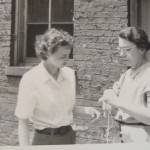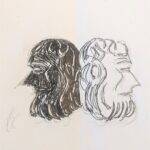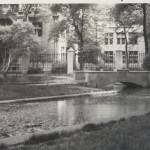I’m realizing, as I cope with age and its disabilities, that a good part of the fear of growing old is loss of place—of being a part of something larger than myself—and the importance this plays in our identity. For many, especially women of my age, family remains the primary group, and in many cultures this insures that the elderly retain a place. In American culture, however, with its stress on independence and individual achievement, “place,” becomes more and more the workplace or profession, which simply retires the elderly. To my mind, however, the culture of our birthplace retains far more power than we recognize.
I still identify as a Midwesterner, despite the fact that my parents were members of the academic community, my mother was a rebel from that culture. She retained, and passed to her daughters, the physical endurance and self-reliance of the pioneer woman, dressed the part, and never, I think, felt “at home” among academic women. I once wrote this about her in response to a prompt to write on the word, “Hands:”
My mother hated her hands. “Too big,” she said, “and knobby.” Usually reddened and nicked. A farmer’s hands that marked her as from another place. All wrong for academic teas and women’s auxiliary clubs, where she’d look around at those soft white dainty hands that lay quietly in well-clad laps, tasteful rings sparkling.
hands that lay quietly in well-clad laps, tasteful rings sparkling.
It wasn’t that she had no friends. The half dozen women who gathered monthly, her sewing circle, all loved her. Their friendship held steady as their children grew and departed. . . .. Still, I never remember a time when she didn’t look around at the delicate fingers, stitching away as they talked, and speak angrily about her own.
Mind you, she was a fine seamstress. She sewed everything we wore, from pajamas to winter coats to wedding dresses. They handled everything from canvas to silk. Dexterity was not the issue. It was place. She wasn’t one of them, and she was deaf to their admiration. Though she lived more than a half century among them, she remained a South Dakota preacher’s daughter set down among the academic elite. Her hands told the story.
I remember them beating egg whites or cake batter, helping puppies to be born. I see them scarlet as she pinned wet sheets to the backyard lines in temperatures barely above freezing. I watch them grow red and sore as she plucked pinfeathers and cleaned the insides of the Thanksgiving turkey. I still see them glow in the steam at the boiler, bleaching my father’s white shirts, wringing out dishrags and mops, scrubbing Chicago soot from walls and floors and windows. And, of course, I remember them at the sewing machine where their size did look awkward as she threaded needles or handled lace. I have no memory of them at rest.
Over and over, as my sister and I grew, my mother expressed her relief that our hands were not like hers. Our hands, plus our slender ankles, marked us as relieved of a grievous burden. We belonged. That, or course, didn’t save us from scrubbing walls, or stitching hems, ironing shirts or beating eggs. Though we were occasionally taken to university events as academic offspring, the gothic enclosed quadrangles a block away were, for us, simply a place to skate or ride bikes. We had little regard (yet) for the expectations they immortalized.
The other day, a good friend pointed to my mother’s hands in a family wedding picture. They hung at her sides, fingers slightly curled, as though just finished with some task or uncomfortable with such inactivity. “You hold your hands just like that,” she remarked.
It wasn’t until I was grown, married, with a child of my own, that I discovered the flip side of the culture she passed on. I went with my parents, my daughter, my sister and her three boys, to a reunion of my mother’s family in rural Minnesota. I watched her father and family welcome my parents, my sister and her tribe of small boys, then realized my two-year-old and I had been left at the curb. Finally, a younger wife approached me and offered her condolences that my child was a girl. Here, in-bred prejudices rule; mothers of daughters have no status. On another occasion, while visiting my husband’s Nebraska-bred family in Oregon, I was told to stay in the car while my husband visited his brother.
Clearly, I did not belong. “Belonging,” in small towns that have little contact with diverse backgrounds comes with the exclusion of difference, and anti-intellectualism—just a word in a sociology text—is as alive in that culture as other forms of bigotry. Its members would term it as “defense of the ordinary man” or “a violation of a deep-seated belief in equality.” To claim affiliation with this rural version of American culture requires acknowledging its determination to exclude all of the rest of us.
 Further, that mistrust of difference, I think, is what made them vulnerable to fear, as television and media became populated with people from other races and cultures. In addition, the technological revolution increasingly made the nation the property of the educated. That communal fear only awaited a Messiah who would turn that fear into hatred, conspiracy, and communal delusion.
Further, that mistrust of difference, I think, is what made them vulnerable to fear, as television and media became populated with people from other races and cultures. In addition, the technological revolution increasingly made the nation the property of the educated. That communal fear only awaited a Messiah who would turn that fear into hatred, conspiracy, and communal delusion.
The world’s religions have long taught the hazards of being human, and surely we’ve all encountered the contrary pulls of belonging and doing what’s right. History can also teach our children both their vulnerabilities and their strengths—as individuals, communities, and nations.




Comments are closed.